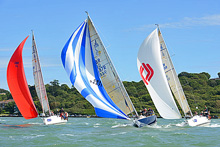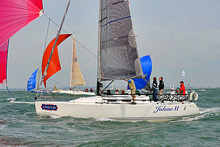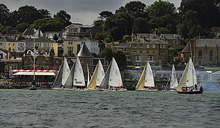 J/109 Wins Black Fleet Overall
J/109 Wins Black Fleet Overall(Cowes, Isle of Wight, England)- As has been the case over the past several Cowes Weeks, the thousands of sailors having fun divining what the weather Gods have in store for them on the capricious Solent will always be a source of endless debate in the Guinness tent-- for both the podium winners that day as well as those who were on the losing end of the bets on which way was better or fastest. In the end, following on their great performances in Scotland and Ireland, the J/97 FEVER GLENFIDDICH (scotch, that is!) sailed by Grant Gordon and crew had a dominant performance to eclipse IRC Class 5. Other J/stablemates faired well in the broad cross-section of conditions presented to them over the course of the week.
The regatta dawned bright and sunny on day one with a brisk east to south-east wind averaging 15-20 knots, but with gusts above 25 knots, provided exhilarating conditions for the first day of racing. With the strongest gusts forecast to be in the Eastern Solent, the dayboats in White Group classes starting from the RYS line were sent on a downwind leg to a course in the western Solent, before beating back to finish on the RYS line.
In IRC Class 2, Duncan McDonald and Phil Thomas’ J/111 SHMOKIN' JOE led the fleet away, all starting towards the northern end of the line. However, while SHMOKIN' JOE and others were the first boats to cross the finish line, all had been among the seven in the class that were OCS at the start! Ouch.
 By the second day the fleet saw plenty of sun and a south-westerly breeze that built to give perfect sailing conditions in 14-17 knots of wind for the event’s Family Day. An erratically moving weather trough that brought a line of showers and light winds to Cowes just before racing was scheduled to get underway presented a headache for race officials. With the trough forecast to leave a 50-60 degree windshift in its wake, the ideal was to wait for it to pass, but it had earlier stalled for 90 minutes and threatened to do the same over Cowes. To everyone’s relief it moved away just in time to allow the starting sequences to get underway with minimal delays.
By the second day the fleet saw plenty of sun and a south-westerly breeze that built to give perfect sailing conditions in 14-17 knots of wind for the event’s Family Day. An erratically moving weather trough that brought a line of showers and light winds to Cowes just before racing was scheduled to get underway presented a headache for race officials. With the trough forecast to leave a 50-60 degree windshift in its wake, the ideal was to wait for it to pass, but it had earlier stalled for 90 minutes and threatened to do the same over Cowes. To everyone’s relief it moved away just in time to allow the starting sequences to get underway with minimal delays.The J/109 class enjoyed the closest of racing today, with tightly fought battles right round the 19.6-mile course and a number of protests. At the start, the pack was bunched at the northern end of the line near the committee boat, with Christopher Sharples and Richard Acland’s JOLENE ll looking best placed.
 JOLENE ll quickly tacked onto port, with Alex Ohlsson and Neil Maclachlan’s JAI HO following close behind and Dutch entry Arjen van Leeuwen’s JOULE just astern, but to windward. When they passed to the south of Lepe Spit on their way to Cowes Radio buoy, JOLENE ll still looked best placed at the head of the fleet, but it was clear many boats were locked in tight battles. As they ran past Egypt Point under asymmetric spinnakers on the way to the finish, the leading group was still neck and neck, with each boat surging back and forward by half a length as they alternately picked up speed in a gust, or on top of a wave.
JOLENE ll quickly tacked onto port, with Alex Ohlsson and Neil Maclachlan’s JAI HO following close behind and Dutch entry Arjen van Leeuwen’s JOULE just astern, but to windward. When they passed to the south of Lepe Spit on their way to Cowes Radio buoy, JOLENE ll still looked best placed at the head of the fleet, but it was clear many boats were locked in tight battles. As they ran past Egypt Point under asymmetric spinnakers on the way to the finish, the leading group was still neck and neck, with each boat surging back and forward by half a length as they alternately picked up speed in a gust, or on top of a wave. In the most adrenaline-filled finish of the day, JET, sailed by the Stanley, Walker and Williams team, extended into a marginal lead three boat lengths from the line. Two seconds after she took the winner’s cannon, another resounding bang signaled Jonathan Calascione and Jonny Goodwin’s HARLEQUIIN crossing the line. The podium appeared complete when Jamie Sheldon’s JIGSAW finished eight seconds later. With JOLENE ll crossing the line 16 seconds afterwards, the first four boats finished within 26 seconds of each other. However, both leading boats were the subject of protests. HARLEQUIN had accepted a time penalty, leaving her fourth and JOLENE ll third. But JET lost her protest and was disqualified, leaving JIGSAW as winner of the Royal Thames Danish Dish, with JOLENE ll second. There was still more drama to come in this fleet – the next two boats in the class – JOULE and Tony Dickin’s JUBILEE – finished, just six seconds apart. Less than two minutes after that, the line was thick with J/109s, with seven boats finishing in only 38 seconds.
“The finish was great,” says Ross Walker of JET, the first boat across the line. “It’s what one-design racing is all about – it was fantastic to have four boats finishing in line abreast at the end of the race. Even though we lost the protest we’re still very happy because it was such as great race – the course setters did a grand job and the lead changed several times.
‘The class this year is still very competitive, but it has more of a family and friends feel than in the past. Most of my crew are teenagers, who are having the time of their lives – we have two of the children of the crew of BASIC INSTINCT [another J/109] on board, as well as my goddaughter, while my daughter is racing on JIGSAW.”
 In the J/80 class, Gillian Ross’s ROCK & ROLL started closest to the outer distance mark, nicely powered up and close to the line, and was first to tack offshore. Doug Neville-Jones’s JASMINE started towards the inshore end and was similarly well placed close to the line. A few minutes into the race, Jamie Diamond’s RASCAL, the most inshore of the fleet, appeared to hook into a favourable wind shift. AQUA-J, sailed by the Stuart, Evans and Simonds syndicate, also clearly liked the look of the left-hand side of the course, tacking onto starboard and passing ahead of RASCAL. The rest of the fleet at this stage, however, opted to stay offshore in the stronger tide.
In the J/80 class, Gillian Ross’s ROCK & ROLL started closest to the outer distance mark, nicely powered up and close to the line, and was first to tack offshore. Doug Neville-Jones’s JASMINE started towards the inshore end and was similarly well placed close to the line. A few minutes into the race, Jamie Diamond’s RASCAL, the most inshore of the fleet, appeared to hook into a favourable wind shift. AQUA-J, sailed by the Stuart, Evans and Simonds syndicate, also clearly liked the look of the left-hand side of the course, tacking onto starboard and passing ahead of RASCAL. The rest of the fleet at this stage, however, opted to stay offshore in the stronger tide.By the finish Simon Ling’s RAFBF SPITFIRE held a big lead, almost three minutes ahead of another Young Skipper’s trophy contender, William Goldsmith’s EXESS, who in turn enjoyed a three and a half minute advantage over JASMINE in third place.
By the time of the Sportsboat start at 1125, the sun was streaming through ever-larger gaps between clouds with increasing intensity and frequency. The majority of the fleet, which is racing under IRC, opted to start at the outer end of the line, with Royal 4, one of the modified J/80s owned by the RYS and Royal Thames YC looking good. On corrected time the lower-rated boats came out towards the top of the fleet. Charlie Esse, Anthony Esse and Jason Sivyer’s modified J/80 DARWIN PROPERTY INVESTMENT MANAGEMENT was second.
On Monday, the defining feature of the third day of the regatta was a gusty and shifty southerly wind that varied from less than 10 knots at times to gusts of more than 20. After a bright morning, a band of cloud with showers on its leading edge was moving eastwards towards Cowes, with very light winds forecast to follow in its wake. As a result, relatively short courses were set to make good use of the day’s best winds.
By Tuesday, the fourth day, Cowes dawned with plenty of sun and light southerly winds that started to build at 0900, reaching 10-12 knots by the time of the first starts. Later the breeze increased still further, to give puffs of up to 16 knots by late morning, before easing back to a mean speed of just over 10 knots.
White Group dayboats that started from the Royal Yacht Squadron (RYS) line headed towards the east, fighting an ebb tide. Despite this, a lot of boats were over the line at the gun, and two starts had to be recalled. At the other end of the spectrum were those who allowed themselves to be swept too far down tide of the start. Most of the successful boats started around one-third of the way out from the shore, where they gained some advantage from a weaker tidal stream but were also able to protect their air from other boats.
Then came an enormous wake-up call on Wednesday-- the proverbial "tempest in a teapot", and then some! A vigorous and unstable cold front, associated with an un-seasonally deep low pressure system moving across southern England, upset plans for racing at Cowes Week today. Although mean wind speeds for much of the day were not forecast to be particularly severe, the possibility of sustained squalls of 33-34 knots was a serious concern for race officials.
 As a result racing was abandoned for the dayboat classes in White Group and also for the smaller boats in Black Group, while the larger boats continued racing. It turned out to be a frustrating morning for many, with big holes in the wind between the showers, along with mammoth wind shifts. Between 1340 and 1350 the wind at Lymington Starting Platform varied from 9 to 33 knots, shifting by almost 40 degrees. Over the next 10 minutes it held a more constant direction, but rapidly strengthened to an average of 27 knots, with peak gusts of over 42 knots. The squalls moved quickly up the Solent, with the first big gusts hitting Cowes just after 1400, as the leaders in IRC Class 4 were closing the finish. Flogging sails could be seen on boats that weren’t ready for the sudden change in conditions, while those who were prepared to quickly change gear for the stronger winds powered past, making good gains
As a result racing was abandoned for the dayboat classes in White Group and also for the smaller boats in Black Group, while the larger boats continued racing. It turned out to be a frustrating morning for many, with big holes in the wind between the showers, along with mammoth wind shifts. Between 1340 and 1350 the wind at Lymington Starting Platform varied from 9 to 33 knots, shifting by almost 40 degrees. Over the next 10 minutes it held a more constant direction, but rapidly strengthened to an average of 27 knots, with peak gusts of over 42 knots. The squalls moved quickly up the Solent, with the first big gusts hitting Cowes just after 1400, as the leaders in IRC Class 4 were closing the finish. Flogging sails could be seen on boats that weren’t ready for the sudden change in conditions, while those who were prepared to quickly change gear for the stronger winds powered past, making good gainsBy the sixth day, Thursday, the weather started settling down as the fleets themselves also started to establish a pecking order with regards to whom had begun to establish almost unassailable leads over their competitors. With winds averaging 15 knots, with some stronger gusts, the sailors were provided ideal conditions. This led to a fifth win for Jonathan Calascione and Jonny Goodwin’s J/109 HARLEQUIN, putting them at at the head of the class’s overall standings, while a fifth place for Christopher Sharples and Richard Acland’s JOLENE ll was sufficient to secure second overall. However, half a dozen boats were still in contention for third with two days to go.
Meanwhile, able to secure class victory with a day spare with a third place was Grant Gordon’s J/97 FEVER GLENFIDDICH in IRC Class 5- truly a dominating performance in a very tough class over many past IRC 4/ IRC 5 Cowes Week champions in the class, including Adam Gosling's Corby 30 YES!
The seventh day, Friday, saw racing concluding for the White Group dayboat classes, including the J/80. The first leg was a tight spinnaker reach for most classes, with the most enthusiastic competitors hoisting as early as possible. However, only the best sailors were able to get them filling in the disturbed air on the start line and for some it was initially more of a hindrance than a benefit.
 An individual recall on the J/80 start saw the Stuart, Evans and Simonds syndicate’s AQUA-J return to restart. It was only when the X-flag remained up that William Goldsmith’s young crew on EXESS, contenders for the Under 25 Trophy, and lying second overall in the class, realized they also needed to drop the spinnaker and return. Goldsmith’s crew did well to recover their big deficit, finishing third behind Simon Ling’s RAFBF SPITFIRE and Jamie Diamond’s RASCAL. Ling won the class overall, counting only first places, with Goldsmith second, and a fourth place today was enough to secure third overall for Geoffrey Payne’s SURF & TURF by a two-point margin.
An individual recall on the J/80 start saw the Stuart, Evans and Simonds syndicate’s AQUA-J return to restart. It was only when the X-flag remained up that William Goldsmith’s young crew on EXESS, contenders for the Under 25 Trophy, and lying second overall in the class, realized they also needed to drop the spinnaker and return. Goldsmith’s crew did well to recover their big deficit, finishing third behind Simon Ling’s RAFBF SPITFIRE and Jamie Diamond’s RASCAL. Ling won the class overall, counting only first places, with Goldsmith second, and a fourth place today was enough to secure third overall for Geoffrey Payne’s SURF & TURF by a two-point margin.Although a handful of winners had emerged Thursday amongst various classes, Friday was the last day of racing for the overall prizes for Black Group classes. Jonathan Calascione and Jonny Goodwin’s HARLEQUIN had already secured an overall win in the J/109 class, but was out again today, notching up an impressive sixth win to take overall victory in Black Group. Grant Gordon’s J/97 FEVER GLENFIDDICH won IRC Class 5 again to take second in Black Group.
A new prize for 2012 was the J/111 Cowes Week Challenge Trophy, which went to J/111 class winners Jeez Louise, skippered by James Arnell. This is the second consecutive year a Brighton-based crew has won the class, with Duncan McDonald and Phil Thomas’ Shmokin Joe winners in 2011.
In the J/92 & J/92s Division, J'RONIMO won with BLACK JACK 2nd and JUST ENOUGH 3rd. In the J/97 Division, it was FEVER GLENFIDDICH leading the pack home, followed by JACKAROO in 2nd and JET in 3rd. In the J/122 Division, GHOST was first followed by THE SISTERHOOD in 2nd and MINT JULEP in 3rd.
 In the extra-special awards category, the Under 25s Trophy went to the gang on the J/80 EXESS with William Goldsmith! Job well done mates!
In the extra-special awards category, the Under 25s Trophy went to the gang on the J/80 EXESS with William Goldsmith! Job well done mates!Additional J Boat success was had by the new J/70, which entered the sportsboat class on day six. After a disappointing start at the back of the fleet, the exciting new 23 footer managed to charge her way through the fleet to finish second over the line. After the handicaps had been applied, the J/70 had earned her maiden UK victory! Sweet! Thanks for the news contributions by Rupert Holmes. Sailing Photo credits- Rick Tomlinsom For more Cowes Week sailing information





0 comments "J/97 Scotches Cowes Week", Baca atau Masukkan Komentar
Post a Comment